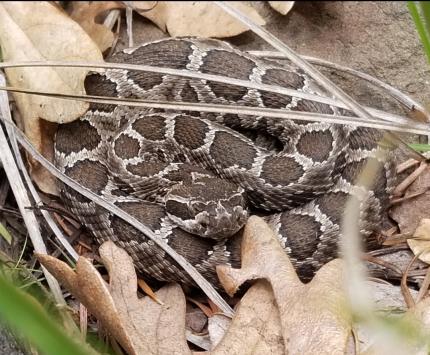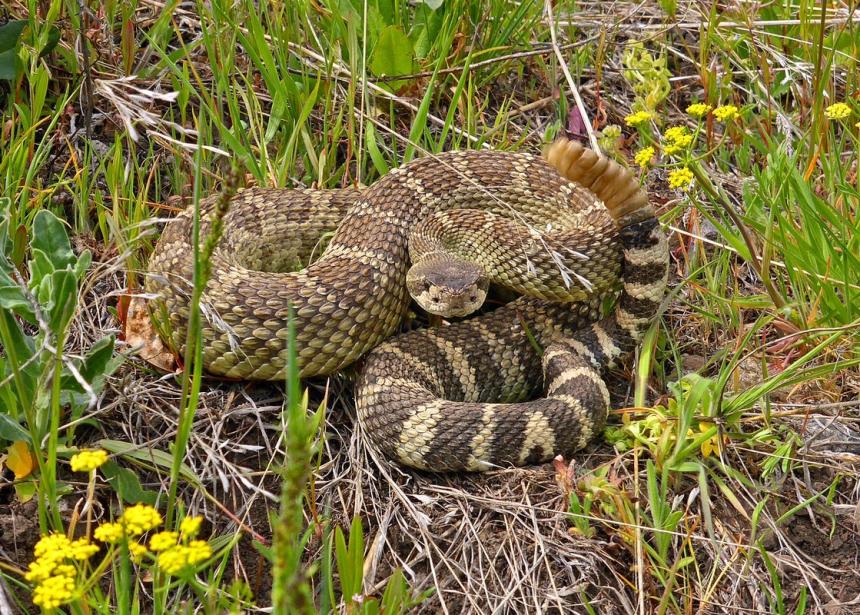This snake is common and widespread in eastern Washington. However, numbers in many areas have declined because of habitat loss, excessive hunting at den sites, and destruction of den sites.
According to NatureServe, the state conservation status of the western rattlesnake population is considered “secure” in Washington.
Caution: This is a venomous and potentially dangerous snake. Rattlesnakes rarely strike unless harassed, handled or stepped on, but any encounter within the striking range could result in a bite.
Description and Range
Physical description
The western rattlesnake is the only snake in Washington with a rattle and facial pits. This is a heavy-bodied snake with large dark spots, a wide triangular head, a distinct eye stripe, and a rattle at the tip of the tail. The largest rattlesnake measured in the Northwest was 59 inches. Most adult snakes encountered in Washington are much smaller (around 2 feet). No obvious external features distinguish males from females.
The cryptic coloration of these snakes varies depending on habitat and substrate color. Typically, the snake is some shade of brown or olive. The spots are dark brown and bordered by black and then white. Additional spotting occurs on the sides of the body. The dorsal (topside) spots fuse with the lateral spots on the tail to form bands. Ventral scales are white with dark blotches. The dorsal scales are strongly keeled and overlapping with 25 rows (range 23 to 29) at mid-body.

The pupils are vertical and the scale above the eye is enlarged. Holes, called “pits,” for reception of infrared heat are located on both sides of the face near the nostrils.
Rattlesnakes bear live young. Recently born snakes (neonates) resemble adults but have more vivid coloration and the rattle is limited to a single, silent, horny segment called a “button.” An additional button is added with each shedding.
The gophersnake is often misidentified as a rattlesnake because the two species have similar markings and defensive behavior. Gophersnakes differ in their physical appearance by lacking a rattle and facial pits. They also have smaller, square, dorsal spots; oval pupils; a narrow eye stripe that extends both to the posterior edge of the jaw and below the eye; and scales that are less keeled.
Nightsnakes resemble juvenile rattlesnakes, but they differ in lacking a rattle and facial pits. They also have smaller, more numerous dorsal spots that are not outlined in black and white, a pearly white belly with no other markings and smooth scales.
For more details about western rattlesnake, see the Washington Herp Atlas.
Ecology and life history
In Washington, western rattlesnakes primarily occur in shrubsteppe habitats but are also found in Oregon white oak, ponderosa pine and other open forest types. Talus and basalt rock outcroppings are used for overwintering.
Rattlesnakes are active during the day when temperatures are moderate but switch to nocturnal activity during the hottest months of the year. When not active, they shelter under shrubs and rocks.
In most of the Columbia Basin, western rattlesnakes emerge from their overwintering sites (hibernacula or dens) in April. Activity is limited to the vicinity of the overwintering site for 2 to 3 weeks and then they disperse to their summer foraging areas.
Reproduction takes place in the spring near the den site. Young start to appear in late August.
Adults return to the overwintering sites starting in late September, although activity may continue until late October depending on location and temperatures.
Geographic range
Western rattlesnakes occur east of the Cascade Mountains in the East Cascades, Columbia Basin, Okanogan, and Blue Mountain ecoregions. The furthest west they have been documented is in the Columbia Gorge approximately 1 mile west of Dog Mountain in Skamania County.
This map from the Washington Herp Atlas illustrates the distribution of western rattlesnake in Washington based on records in the WDFW database as of 2016. If you see this species in areas that are not indicated on the map or have more recent observations (less than 10 years), please share your observation using the WDFW wildlife reporting form.
For a map of range-wide distribution and conservation status of this species, check out NatureServe Explorer and the International Union for Conservation of Nature Redlist.
Regulations
Licenses and permits
Be advised that collection of this species is only permitted under a WDFW Scientific Collection Permit for research and educational activities.
Conservation
The state conservation status of the western rattlesnake is “secure” based on the assumption that it is common according to the most current records.
The main conservation concern for this species is excessive hunting and wanton killing of snakes emerging from hibernation, as well as destruction of communal den sites. Both can result in local population declines and even local extirpation.
Radio-telemetry studies by Washington Department of Natural Resources Natural Heritage Program in Grant County and Washington Department of Fish and Wildlife in Okanogan County were conducted in 2003 and 2004 to locate communal hibernacula.
Living with wildlife
Snakes are among the most misunderstood of all animals. Of the dozen or so species of snakes found in Washington, only the western rattlesnake is capable of inflicting a venomous bite, which it seldom does. All snakes are an important part of the natural food chain, eating a variety of prey—from mice and birds to frogs and insects.
Observe snakes, like all wild animals, from a respectful distance. Learn more about living with snakes.
Resources
References
Ashton, K. G., and A. de Queiroz. 2001. Molecular systematics of the western rattlesnake, CROTALUS VIRIDIS (Viperidae), with comments on the utility of the D-loop in phylogenetic studies of snakes. Molecular Phylogenetics and Evolution 21:176-189.
Hallock, L. A. 1998. Amphibian Inventory of the Cow Creek Watershed, Lincoln and Adams counties, Washington. Unpubl. Rep. Wash. Natural Heritage Program, Dept. of Natural Resources, Olympia. 11 pp. + appendices.
Hallock, L. A. 1998. Herpetofauna of the Hanford Nuclear Reservation, Grant, Franklin and Bentin Counties, Washington. Unpublished report submitted to The Nature Conservancy, Seattle, WA. 43 pp + appendices
Hallock, L. A. 1998. Herpetofauna Inventory of Bureau of Land Management sites in Douglas, Franklin, Grant, Lincoln, Klickitat, Washington. Unpubl. Rep. Wash. Natural Heritage Program, Dept. of Natural Resources, Olympia. 14 pp. + appendices.
Hallock, L. A. 2004. External attachment of radio-transmitters on western rattlesnakes (Crotalus viridis) to locate communal hibernacula. Unpubl. Rep. Wash. Natural Heritage Program, Dept. of Natural Resources, Olympia. 9 pp.
Klauber, L. M. 1956. Rattlesnakes: their habits, life histories, and influence on mankind. University of California Press, Berkeley, California, 1533 pp.
Pook, C. E., W. Wuster and R. S. Thorpe. 2000. Historical biogeography of the western rattlesnake (Serpentes: Viperidae: CROTALUS VIRIDIS), inferred from mitochondrial DNA sequence information. Molecular Phylogenetics and Evolution 15:269-282.
Prior, K. A. and P. J. Weatherhead. 1996. Habitat features of black rat snake hibernacula in Ontario. Journal of Herpetology 30: 211-218.
Personal communications
Scott Fitkin, Washington Department of Fish and Wildlife, Okanogan County, Washington.
WDFW publications
WDFW educational resources
- Wild Washington Lesson Plan – Herps in Washington - Elementary school students are introduced to the cold-blooded world of reptiles and amphibians, also known as herps.
- Family Education – Amphibians and Reptiles - Slither, hop, or crawl on over to learn about herpetofauna!


